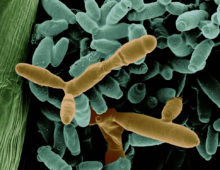The filamentous fungus Neurospora crassa is an important model organism for fungal conversion of biomass. It is unknown how DNA structure is altered in response to stimuli to change expression levels of genes involved in biomass conversion. The goal is to define the global regulatory network of DNA structures in N. crassa and its impact…
Comparative Genomics of Acutodesmus
Green algae are important contributors to global carbon cycling and hold great promise as feedstocks for biomass and biotechnology applications. To date, breeding and natural variation of green algae have not been exploited for strain improvement due to lack of foundational knowledge about strain diversity and sexual cycles. This project will investigate natural strain diversity,…
Reference Genomes for 50 Rust Fungi
Rust fungi are the largest group of plant pathogens. Different species cause disease on important food, timber and bioenergy crops. However, there are comparatively few genetic resources available for this group. The goal of the rust pangenomics project is to provide reference genomes for 50 rust species, including pathogens of JGI plant flagship species (e.g.,…
Comparative and Population Genomics of Xylariaceae
Despite evidence that endophytes play a critical role in plant-microbe interactions, they are poorly represented in genome databases. Leveraging our unique culture collection, the team proposes a genomic survey of the Xylariaceae, one of the largest and most diverse families of fungi made up of endophytic, pathogenic, and saprotrophic (including wood degrading) species. Our project…
Open Green Genomes Initiative
The Open Green Genomes Initiative will generate high-quality genome assemblies and annotations for 35 species representing all major evolutionary lineages in the land plant tree of life. This work will greatly improve comparative analyses of the genes, regulatory networks and metabolic pathways influencing plant growth, responses to environmental stress, and production of valuable plant products….
How Nectar Yeasts Scavenge Nitrogen
The species of yeasts that colonize floral nectar face two major challenges: high osmotic pressure caused by excessive carbon supply and strong resource competition caused by low nitrogen availability. This project is aimed at identifying the genes and pathways that enable nectar yeasts to grow in the carbon- and nitrogen-stressed environment. Nectar yeasts have presumably…
Gene Atlases of Grass-Microbe Interactions
Grasses comprise key food crops, as well as bioenergy feedstock. However, their productivity and biomass is greatly hindered by viral, fungal, and bacterial infections, which cause yield losses of up to 60 percent. This proposal seeks to build comprehensive gene atlas maps for diverse bioenergy grass-microbe interactions, including pathogenic and beneficial interactions in two grass…
Shaping the Brachypodium Polyploid Model
Polyploid plants are often larger than their diploid progenitors and can be more stress tolerant. Some of the world’s most important crops are polyploid. This project uses three small grasses with compact genomes and traits that make them easy to manipulate in the laboratory. Brachypodium hybridum is an allotetraploid formed by interspecifc hybridization between the…
Improving Crop Productivity Strategies
The sustainable production of biofuels from energy crops could greatly benefit from strategies that increase crop productivity in existing agricultural lands. Application of rare earth enzymes (REE) increases crop yields but the molecular mechanisms by which REE increase plant productivity are not well understood. As REE affect the metabolism of methylotrophs, a predominant member of…
Impact of Plant Cell Wall Modification
ORNL researchers are testing the hypothesis that genetic modification of plant cell wall has cascading and quantifiable impacts on its secondary metabolome and the associated functional microbiome. The hypothesis is based on the team’s recent finding that modification of a plant cell wall pathway gene, PdKOR, an endoglucanase, in Populus can impact its ability to…



